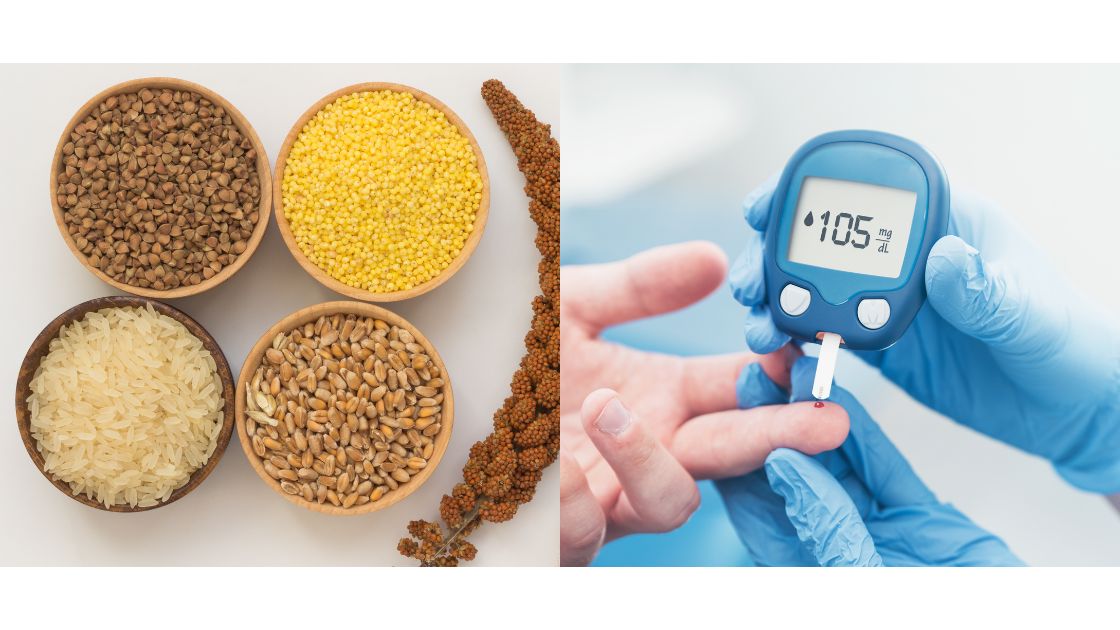Introduction:
Diabetes management has various dimensions, but one fascinating path to investigate is millet. The fact that these are ancient cereals and yet are nutrient dense has made them an object of interest for their potential in controlling blood sugar levels. However, there is a doubt regarding their effect on glucose levels. We need to find the association between millets and blood sugar control through thorough investigation. Our goal in this paper is therefore to review scientific findings from different experts so as to give insights into this vital element of dietary intervention in diabetes care.
(Millets and Blood Sugar Management)
Understanding Diabetes:
Diabetes appears in two main forms which include type 1 and 2. Type 1 diabetes is an autoimmune disease. It leads to the destruction of cells in the pancreas that make insulin. So, it requires life-long insulin therapy. Type 2 diabetes is usually from insulin resistance. Cells become insensitive to its action, or there is too little insulin. Lifestyle factors, like diet, genetics, and activity, cause type 2 diabetes. High blood sugar can cause many complications. These include heart, nerve, and kidney diseases. So, we need good management strategies.
Millets: Ancient Grains with Modern Relevance:
Millets throughout the world have been grown for thousands of years in a number of different places. These are robust cereals whose nutritive value and environmental stability have attracted fresh interest. Millets are rich in complex carbohydrates, fiber, protein, vitamins, and minerals, making them a valuable dietary component. They can adjust to different weather conditions and need less water; this makes them ideal for sustainable agriculture which is meant to address current ecological issues.
Millets and Blood Sugar Management: Debunking Myths

Millets, although high in carbohydrates, have characteristics that are different from those of refined grains when it comes to their effect on blood sugar. They have a low glycemic index (GI) suggesting slower digestion and step-by-step glucose release into the blood stream. This slow absorption prevents sudden hikes in
Read All Articles: treeoflifecentre
Millets’ suitability for diabetics is predicated on their ability to help manage blood sugar levels. Additionally, millets contain rich amounts of soluble fiber that slow down the absorption of glucose and make you feel full. Evidence shows that diabetes patients who feed on millets will have a better blood sugar control system as well as general health outcomes.
Research Insights:
There have been many studies that investigated how millets influence blood glucose levels and can be used to manage diabetes. For example, research published in the Journal of Nutrition and Metabolism compared glycemic responses among type 2 diabetes sufferers who were given either rice-based or millet-based meals. The results showed that having lower after-meal sugar levels than those who ate rice based diet imply better control over blood sugar with millets. In a separate study conducted by International Journal of Food Sciences and Nutrition — random controlled trial it was found that diabetics’ fasting blood sugar levels as well as HbA1c decreased significantly upon inclusion diets which included finger millet in their daily intake were added to diabetic patients’ diets.
These outcomes stress the possibilities in millets as a solution to diabetes and metabolic health. However, further research is required to understand the precise ways through which millets may be of benefit to blood sugar regulation and diabetes outcomes.
Millets: A Versatile Addition to Diabetic Diets
Millets are good for the diabetic diet since they do more than just control blood sugar levels. These crops are highly fibrous, enabling digestion health, bowel movements’ regulation and prevention of constipation. Moreover, it helps you feel full and cuts down on calories taken thereby managing weight effectively which is a major part of diabetes treatment. Lastly, millets come with minerals like magnesium, potassium and antioxidants that help in maintaining general well-being and lowering chances of getting chronic diseases such as heart disease and some types of cancers.
Addressing Concerns and Misconceptions:
Although there is mounting evidence supporting the use of millets by people who have diabetes, this does not stop misconceptions on their suitability and safety. This is one of the concerns I see being raised all over; that is, some feel that eating common grains may result in elevated sugar levels in the blood.
However, it’s worth noting that carbohydrates are not made equal while their glycemic response varies due to several factors such as fiber content, processing and preparation method. Millets definitely contain carbohydrates but their low glycemic index combined with high fibre content makes for slow digestion and gradual release of glucose into blood which can aid in stabilizing blood sugar after a meal when consumed as part of balanced diet.
Practical Tips for Incorporating Millets into the Diabetic Diet:
This can be done by incorporating millets gradually and creatively into the diabetic diet, focusing on balance and moderation. Here are some straightforward pointers to help you incorporate millets into a diabetic-friendly diet:
- Ease in slowly: Commence by adding minimal millet servings to your meals and gauge how much sugar your blood can take.
- Use whole grains: Choose whole grain millets like foxtail millet, finger millet and pearl millet which contain bran and germ layers that keep the nutrients in them as well as fiber.
- Combine with protein and fibre: Combine millets with lean proteins, healthy fats and vegetables rich in fibers to make balanced meals that will help you become full for longer while stabilizing your blood sugar.
- Experiment with recipes: Try out different millet based recipes such as salads, soups, stir-fries and porridges and explore new tastes and textures at the same time as you provide for your nutritional requirements.
- Monitor blood sugar levels: Watch your blood sugar levels for a while after you eat foods that include millets so as to tell how they affect you and then determine the amount to eat.
Exploring the Nutritional Profile of Millets:
It is necessary to assess the nutritional facts of millets more closely to fully recognize their role as potential diabetes control agents.
- Carbohydrates: Within millets carbohydrates are present, but this complex carbohydrate structure rather than refined grains makes glucose to be released at a slow constant rate. Thus these gradual releases prevent sudden hikes in blood sugar levels leading better glycemic control.
- Fibre: Millets have high amounts of dietary fiber, such as both types of soluble and insoluble fibers. Soluble fiber forms a gel like substance that slows down the absorption of glucose and cholesterol in the gut, while insoluble fiber adds to stool bulkiness and regular bowel movement.
- Protein: Millets are a good source of vegetal protein that is vital for construction and rebuilding of tissues, boosting immunity and protecting muscle fibers. It also lowers glycemic impact of meals and has the benefit of increasing satiety through blood sugar regulation.
- Vitamins and minerals: A variety of vitamins and minerals are found in millets, these include: iron, magnesium, phosphorus, zinc as well as B vitamins such as thiamine, riboflavin and niacin. They contribute significantly to energy metabolism, nerve function and immune health thereby enhancing general well-being.
Impact of Millets on Weight Management:
Weight management is an important element in the healthcare of people with diabetes since obesity and excess body weight increase risks of getting type 2 diabetes. The incorporation of millets into the diet for diabetics can be helpful in managing weight due to their high fiber content, low energy density and satiating benefits. Millet is a fibrous food that control appetite, decrease calorie intake and provide fullness sense thus assisting in weight reduction or maintenance. Furthermore, slow digesting carbohydrates present in millets help regulate blood sugar levels while preventing excessive eating hence are beneficial for managing diabetes.
Millets and Heart Health:

In people with diabetes, cardiovascular disease remains the main cause of morbidity and mortality which underscores the need for strategies for reduction of cardiovascular risk. Presently researchers are suggesting that the incorporation of millet into the diabetic diet may have an effect on cardiovascular health that goes beyond glycemic control.
Millets are rich in minerals such as magnesium, potassium, and antioxidants that promote heart health by affecting blood pressure regulation, cholesterol levels and antioxidative stress mechanisms. Studies show that high intakes of whole grain foods including millets are linked with a decreased probability of getting cardiovascular diseases or related conditions.
Millets also serve as an overall approach to managing diabetes which involves various issues concerning this condition as well as its future consequences in form of complications caused by uncontrolled blood sugar levels.
Addressing Specific Concerns:
On the other hand, there may be some specific concerns about the preparation of these types of grains, how they can be obtained in the market and their taste. It is important to address these issues so as to encourage millets consumption among diabetic individuals.
For instance, people may be uncertain about the cooking of millets and their availability in grocery shops. When it comes to sourcing or preparing millets, offering practical suggestions as well as resources can provide a way forward. Moreover, we can demolish fallacies on taste by making known their rich culinary potential and flavorsome recipes which are aimed at stimulating activity in the kitchen.
Healthcare professionals can help millets become part of a healthy diet for a diabetic, thus improving the control of blood glucose and general health among individuals with diabetes by addressing particular issues and giving them support.
Conclusion:
To sum up, millets are a good addition for diabetics. They help the body gain important nutrients and assist in managing blood sugar levels when taken with a balanced diet. Nevertheless, research shows that millet can impact favorably on glycemic control which eliminates doubts about their suitability to diabetic individuals. By skillfully adding these little grains into the plate or pot human beings with diabetes can vary their foodstuffs while at the same time maintaining healthy bodies and therefore wellbeing.
FAQs for Millets and Blood Sugar Management
FAQs:
Can millets cause blood sugar spikes in individuals with diabetes?
On the whole, millets are considered to have a lower glycemic index than refined grain, but individual responses may vary. Thus, those with diabetes should monitor their blood sugar levels after eating millets and adjust portion sizes up or down accordingly.
Are certain types of millets better for managing blood sugar levels in diabetes?
According to some studies, particular millets like pearl and finger millet may have a beneficial impact on the levels of blood sugar due to their low GI value and high fibre content. Nevertheless, individual tastes and dietary requirements should also be taken into account.
How should millets be prepared to maximise their potential benefits for individuals with diabetes?
In order to optimize the health advantages of millets for managing diabetes, it is suggested that they are prepared in ways that keep their nutritional properties. These involve cooking them by using the minimal processing and avoiding too much added sugars or fats, as well as including them into well-balanced meals which contain proteins, healthy fats and vegetables.

